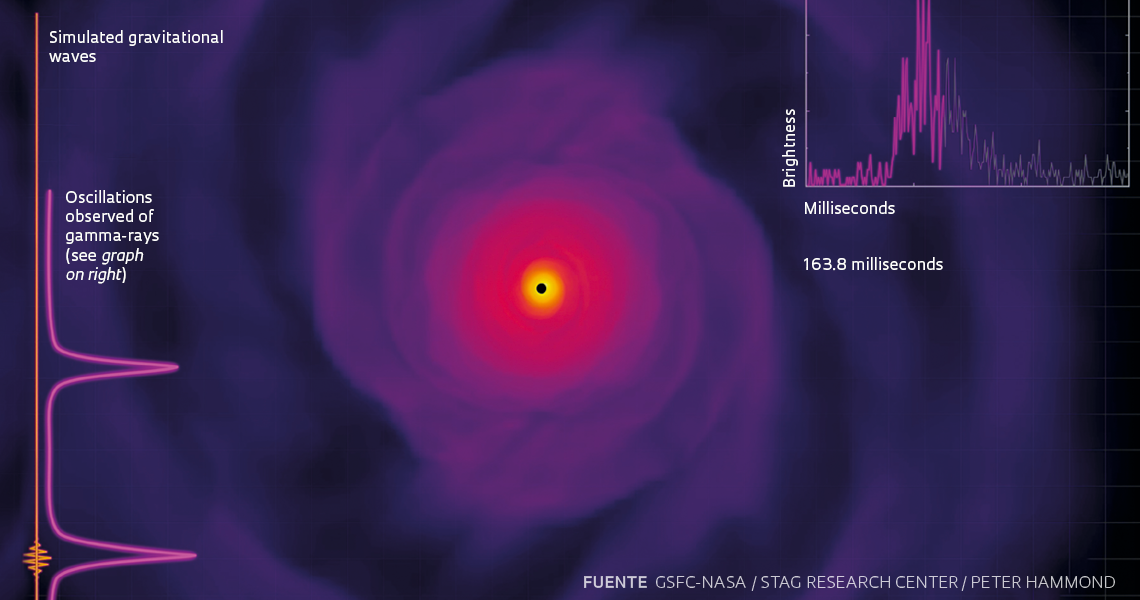An oscillation pattern identified in the signals produced by two gamma-ray bursts, one of the most energetic events in the Universe, appears to indicate the existence of neutron stars with at least 20% greater mass than recorded until today. The lifespan of these mega neutron stars, never yet observed, is purported to be hundredths to tenths of a second. They supposedly are formed as a result of the collision and fusion of two smaller neutron stars. This is one of the phenomena associated with the production of short duration gamma-ray bursts, which generate signals lasting less than 2 seconds. During their fleeting existence, these hypermassive neutron stars in theory revolve around their axis at a rate equivalent to 78,000 rotations per minute, double that observed in any known celestial object.
“We have analyzed over 700 short duration gamma-ray bursts detected in the past decades and have found two signals that, according to simulations, are compatible with the existence of hypermassive neutron stars,” says Brazilian astrophysicist Cecília Chirenti, of the Federal University of ABC (UFABC) and the University of Maryland, USA, lead author of the article published online in the scientific journal Nature in January this year. “This type of neutron star would be an intermediate and dynamic stage of the fusion process of smaller stars, generating a black hole as a final result.”
The origin of traditional neutron stars (not hypermassive) is well known. They form from the remaining core of larger stars that have reached the end of their life, exploded, and expelled their outermost layers of material. This explosion is called a supernova. A typical neutron star is a sphere with a diameter of around 20 kilometers (km) with a mass equal to or twice the Sun’s. Detail: the diameter of the Sun is around 70,000 times bigger than that of a neutron star. Only black holes are more compact than a neutron star.
The two bursts which, according to the study, generated hypermassive neutron stars were recorded by the Compton Gamma-Ray Observatory, a space telescope belonging to the North American Space Agency (NASA) that operated between 1991 and 2000. The first one was recorded on June 11, 1991, and the other on November 1, 1993. The characteristic indication of the formation of a large short-lived neutron star is classified as a quasi-periodic oscillation (QPO), in other words, the star oscillates a few times very quickly and then stops presenting this variation. According to the article, at a point in the fusion process of two smaller neutron stars, the signal produced in the gamma-ray region intensifies and, for a brief moment, a simultaneous emission of two frequencies occurs.
Computer simulations indicate that the formation of hypermassive neutron stars must emit gravitational waves (ripples in the spacetime curvature) that present this same QPO pattern of oscillation. “But the current generation of terrestrial observatories of gravitational waves [Ligo, Virgo, and Kagra] are not sensitive enough to capture these variations,” explains Chirenti, who does her studies in the NASA Goddard Space Flight Center (GSFC). For now, the alternative would be to analyze the gamma-ray bursts to study this elusive form of hypermassive neutron star, the article proposes.
For physicist Raul Abramo, of the Physics Institute at the University of São Paulo (IF-USP), who did not participate in the work, the results of the article open a fascinating window into one of the most dramatic and energetic events in the Universe, the collision of two neutron stars. “The study indicates that we can use not only gravitational waves, but also gamma-rays to study the state and dynamic of the final moments of these systems,” comments Abramo, a specialist in cosmology. “If confirmed, these detections could have shown the first evidence of a totally new type of object, hypermassive neutron stars. This would be the state of the material before it succumbs to the gravitational pull and forms a black hole.”
Italian physicist Riccardo Sturani, from the Institute of Theoretical Physics at São Paulo State University (IFT-UNESP), comments that it is difficult to give more precise explanations about the meaning of the results presented in the work of Chirenti and her colleagues. “It isn’t clear what the signal of these two gamma-ray bursts has that is different in relation to other bursts. But, without doubt, the study pushes the search even further for QPO-type oscillations in the area of gravitational waves,” says Sturani, an expert in this type of emission.
Scientific article
CHIRENTI, C. et al. Kilohertz quasiperiodic oscillations in short gamma-ray bursts. Nature. Online. jan. 9, 2023.


